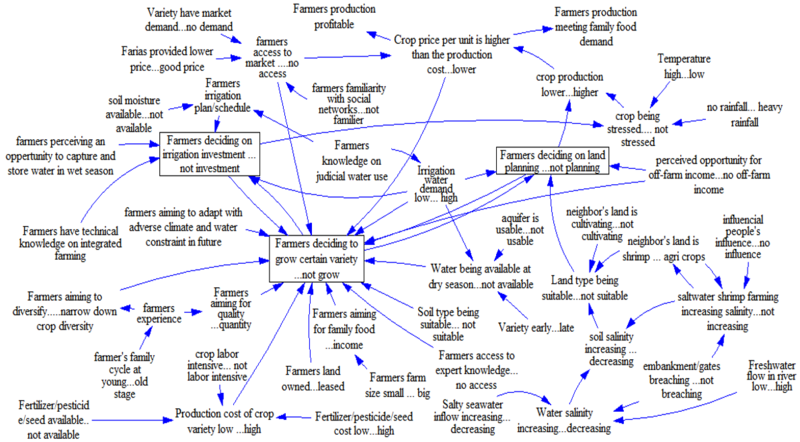Views
Actions
Temporary Drafts
See section Refocused Training in Chapter 31.
The DPP (Development Project Proforma) of DAE focused on agricultural extension through the Farmer Field School (FFS) methodology, which was already implemented by DAE with DANIDA support. The output, including the revised DPP, was the execution of 1492 FFS to transfer modern production technologies for crops, the distribution of a variety of inputs (vegetable seeds, fertiliser, fruit saplings) in 380 (horticulture focused) demonstrations, the general training of DAE staff (75 Departmental Trainers and 150 Farmer Trainers (FTs)), and the financial support to farmer organisations (375 x 20.000 BDT).
The DPP noted that in the selected polders BWDB would organize Water Management Groups (WMGs); DAE would provide crop production technology to these WMGs through a group approach i.e. the FFS approach. The FFS approach had been proven by DAE in Bangladesh to be a solid and practical mechanism through which new knowledge, practices and messages can be transferred to farming communities where the literacy rate is low. The FFS approach is successful because the sessions run over the course of an entire cropping cycle during which the participants are encouraged to implement new practices, resulting in overall high adoption rates.
The logframe of the DAE DPP is inserted in Annex 21-2. Note that it is not compatible with the logframe in the Blue Gold Program Document (i.e. as in Annex 21F.1).
Preliminary Discussion: The DAE DPP set a strict framework for the implementation of agricultural extension through the Farmer Field School methodology. Farmer groups, belonging to the WMGs, were seen as leaders or core actors of value chains. However, the approach to farmers and to WMGs were not aligned. Any linkages between agricultural practices and water management, as well as linkages between farmers and other market actors were beyond the content of the classic FFS.
Blue Gold’s DAE contribution consisted of a small central office to organize the implementation of DAE’s FFS. It was expected to work through the lines of the DAE structure, ‘buying time and services’ in DAE’s line operations. In support of implementation (only) the training of field staff was envisaged. Beyond this, there was limited attention to the involvement of the line in the process.
While the heterogeneity of the households in the polders was observed during Inception, it became better understood through familiarising ourselves with the Rural Transformation Framework. Around 2015 UNCTAD, DFID and IOB published strategy papers on Rural Transformation[i]. In essence, these papers recognise the heterogeneity of rural households and the need to diversify strategies to lift them out of poverty accordingly. At the core is the categorisation of rural households by Dorward, in households ‘stepping-up’ (improving farm production), or ‘stepping-out’ (i.e. stopping subsistence farming), alongside those ‘hanging-in’[ii].
[i] DFID, DFID’s conceptual framework on agriculture 18 Jan 2016, IOB, Household survey baseline report – impact evaluation food security program Bangladesh, 2015, UNCTAD, The Least Developed Countries Report, Transforming rural economies, 2015
[ii] Dorward A, Hanging-in, Stepping In and Stepping Out, Livelihood aspirations and strategies of the poor…
Test[edit | edit source]
| Introduction | Gender Equality and Women’s Empowerment | Poverty focus | |||
|---|---|---|---|---|---|
| |||||
| Sustainability | |||||
Toc[edit | edit source]
| Executive summary: A Call for Action |
|---|
| Section D: BGP Interventions: Participatory Water Management | Section E: Agricultural Development | Section F: Responsible Development: Inclusion and Sustainability |
|---|---|---|
|
|
|
CfA Download[edit | edit source]
| Download the Executive summary: Call for Action in PDF format | |
|---|---|
| Download the English PDF | Download in Bengali (বাংলা) PDF |
